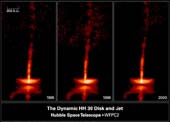|
COMETS EARTH JUPITER KUIPER BELT MARS MERCURY METEORITES NEPTUNE OORT CLOUD PLUTO SATURN SOLAR SYSTEM SPACE SUN URANUS VENUS ORDER PRINTS
PHOTO CATEGORIES SCIENCEVIEWS AMERICAN INDIAN AMPHIBIANS BIRDS BUGS FINE ART FOSSILS THE ISLANDS HISTORICAL PHOTOS MAMMALS OTHER PARKS PLANTS RELIGIOUS REPTILES SCIENCEVIEWS PRINTS
|
Related Documents
Download Options
These images of HH 30 show changes over only a five-year period in the disk and jets of this newborn star, which is about half a million years old. The pictures were taken between 1995 and 2000 with the Wide Field and Planetary Camera 2 aboard NASA's Hubble Space Telescope. Astronomers are interested in the disk because it is probably similar to the one from which the Sun and the planets in our solar system formed. Hubble reveals an edge-on disk (located at the bottom of the images), which appears as a flattened cloud of dust split into two halves by a dark lane. The disk blocks light from the central star. All that is visible is the reflection of the star's light by dust above and below the plane of the disk. The disk's diameter is 450 astronomical units (one astronomical unit equals the Earth-Sun distance). Shadows billions of miles in size can be seen moving across the disk. In 1995 and 2000, the left and right sides of the disk were about the same brightness, but in 1998 the right side was brighter. These patterns may be caused by bright spots on the star or variations in the disk near the star. The dust cloud near the top of these frames is illuminated by the star and reflects changes in its brightness. The star's magnetic field plays a major role in forming the jets (located above and below the disk), which look like streams of water from a fire hose. The powerful magnetic field creates the jets by channeling gas from the disk along the magnetic poles above and below the star. The gaps between the compact knots of gas seen in the jet above the disk indicate that this is a sporadic process. By tracking the motion of these knots over time, astronomers have measured the jet's speed at between 200,000 to 600,000 miles per hour (160,000 and 960,000 kilometers per hour). Oddly, the jet below the disk is moving twice as fast as the one above it. Credits: NASA, Alan Watson (Universidad Nacional Autonoma de Mexico), Karl Stapelfeldt (Jet Propulsion Laboratory), John Krist and Chris Burrows (European Space Agency/Space Telescope Science Institute) |
